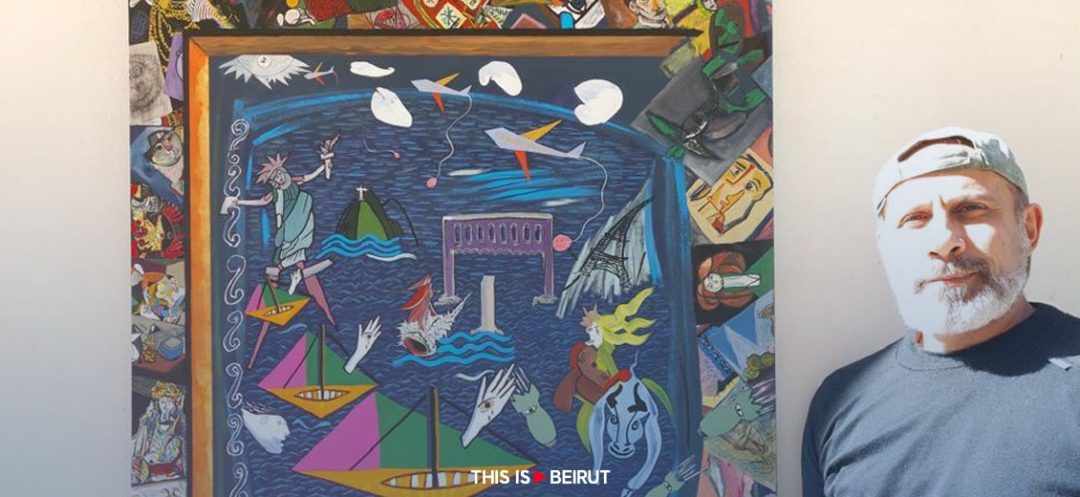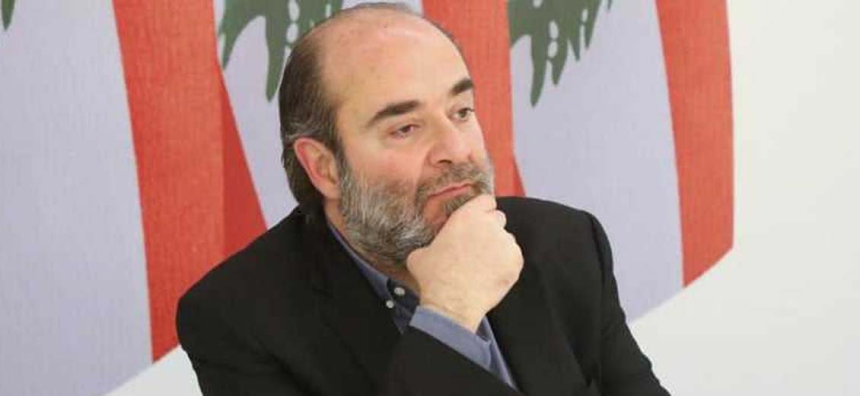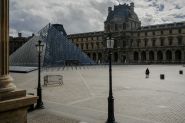
©The artist posing with his work "Emigration after Picasso."
Reynaldo Sayegh is showcasing his latest series of works titled Puertas del Mediterraneo (Doors of the Mediterranean) at the Instituto Cervantes in Beirut from April 18 to April 30, 2024. This exhibition, the result of extensive reflection on the historical and cultural links between Lebanon and Spain, will also be presented at the AZM Cultural Center in Tripoli from May 2 to May 9 and at the Villa Paradiso in Batroun from May 10 to May 15.
In the current global context, it is legitimate to wonder if art can still offer an exit, a solution or even a response to the absurd.
Fortunately, artists cannot help but create or recreate everyday life, escapes and solutions, having first immersed their quills or brushes in their original soil and their experiences.
This is the purpose and mission of Reynaldo Sayegh, an artist who has broken away from the beaten path through a long career as a self-taught painter and a designer and creator of objects present in the majority of Lebanese households, recognized at first glance by everyone who feels nostalgic for the country. This man with an eclectic personality is no stranger to exhibitions. But his latest, Puertas del Mediterraneo (Doors of the Mediterranean), organized in collaboration with the Instituto Cervantes in Beirut from April 18 to April 30, 2024, holds a special significance.
Linking the East to the West, the Levant to Andalusia, Lebanon to Spain, Reynaldo has undertaken what every Lebanese citizen who has experienced the traumatic events of Lebanon should accomplish in their lifetime: an in-depth and cathartic work on memory, an intense search for roots and meaning. Reynaldo Sayegh’s artistic talents, however, allow him to exorcise the lived experience by displaying it on his large canvases illuminated by doors and windows open to the Mediterranean.
A series of 12 works was thus created after a long study on the paths and meeting points of the two countries, and a dialogue was established in the work, characterized by pungent humor and an extreme attention to detail between monuments, symbols, painters, composers, giants of Spanish literature and their Lebanese equivalents and counterparts.
Monasteries of Mount Lebanon and Spanish baroque cathedrals, masterpieces of Picasso’s paintings deconstructed and re-proposed as if in a cubic style canvas exploded by the artist himself, disparate thoughts traced on a chessboard background, Phoenician letters making round trips between Tyre and Crete, Cadmus facing Zeus, Feyrouz honoring Aranjuez through Rodrigo’s concerto, the ideals of Gibran’s prophet greeting those of Cervantes’ wandering knight, the silk road winding from the caravanserais of the Levant to the markets of Valencia—nothing is missing from the call. Various canvases salute History: the waves of occupiers of the land of Canaan, invaders whose civilizations leave to the country a contribution like the fertile silt that engenders the Lebanese character, the different leaders of Lebanese communities coexisting without turmoil, irrefutable proof that the country’s 18 rites are not incompatible, like the three religions of the inhabitants of 13th-century Toledo, former capital of Castile. Finally, it is important to mention the work that traces the highlights of the civil war, enclosed like a tree with poisonous fruits under a narrow arch. Everything is eviscerated, reinterpreted and undoubtedly exorcised in a powerful internal journey that challenges the observer.
After Beirut, the exhibition will continue at the AZM Cultural Center in Tripoli—Arab Cultural Capital of 2024—from May 2 to May 9, and at the Villa Paradiso in Batroun from May 10 to May 15. Every journey undertaken is a discovery of oneself through the discovery of elsewhere, magnificently shared. To discover and rediscover again.
Read more





Comments